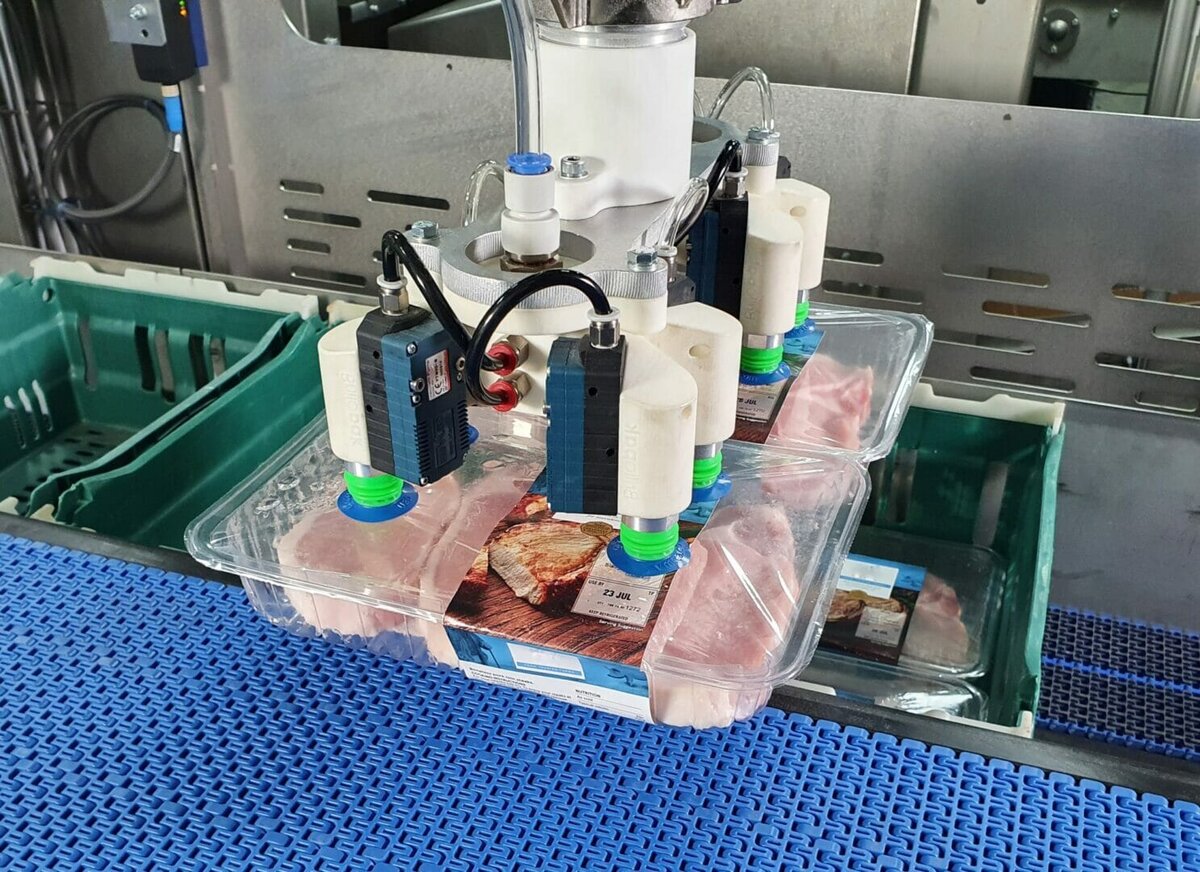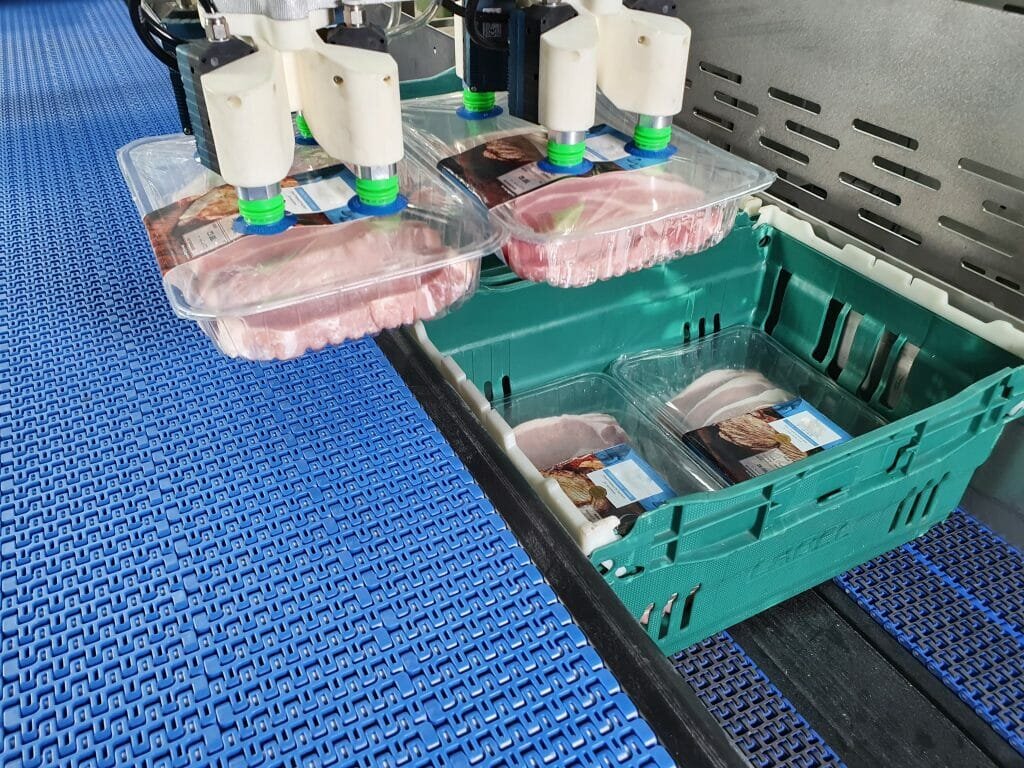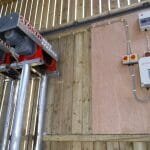A leading UK pork producer has become the first meat industry success story for Brillopak’s UniPAKer robotic crate packer. The last piece of the jigsaw in a new multi-million pound line, the clever robot cell has enabled several staff to be redeployed onto more valuable, less repetitive tasks at a time when labour is in short supply.
Having invested heavily in a state-of-the-art line for cutting, portioning and packaging fresh pork into trays, in 2020, the producer turned its attention to the end-of-line crate packing operation. This process was still manual and COVID and Brexit were compounding the issue of labour availability.
After carrying out some research, the producer approached Brillopak, an agile and innovative designer of robotic packing automation.
“The fact that they are an independent company was important to me, as I know that, as a dynamic meat business, we are more likely to get the attention we need. I also knew that they were working with major supermarkets on automation projects so they had the experience,” said the company’s Factory Operations Manager, who was responsible for leading the project.
The main motivation for automating its crate packing operation wasn’t to reduce head count per se, rather to maximise the potential of existing staff by redeploying them onto more value-adding tasks.
“This in turn will enable us to keep the people we have, as finding good labour is becoming an issue,” he explained.
The producer’s brief was for a small footprint system that could pack multiple tray-sealed fresh pork SKUs, ranging in size from 250g up to 1kg, into plastic retail half crates (300x400mm) at a line speed of 66 ppm, with minimal manual intervention.
Brillopak proposed a solution with its award-winning UniPAKer robot at its centre. This trail-blazing system has already revolutionised the packing of bagged fresh produce such as apples, sprouts and potatoes into crates and now looks set to be a game-changer in the meat, fish & poultry industry.
While tray-sealed packs of meat appear to be a fairly straightforward item to pick and place (they are uniform with flat surfaces and are not overly delicate), this project posed specific challenges that Brillopak had to overcome in specifying a solution.
- The clever robot cell has enabled several staff to be redeployed onto more valuable, less repetitive tasks at a time when labour is in short supply
- This cost-effective and space-efficient UniPAKer works well for tray-sealed meat packs, which can’t be handled at very high speeds as the film lid may tear.
For maximum efficiency, trays have to enter the robot cell in the same orientation. On this line, however, some trays exit the tray sealer narrow-edge leading, whereas others are wide-edge leading, depending on the tooling format. Brillopak addressed this potential issue with the installation of a servo turner that repositions trays after they leave the tray sealer.
The other challenge that this project presented was meeting the customer’s throughput expectations within the available space – the lines in this factory are incredibly close together.
A standard single delta robot cell would have fitted into the space, but wouldn’t have been fast enough to make the project viable from a payback perspective. Adding a second robot would have made the system fast enough, but on an unacceptably large footprint.
Brillopak’s solution was to specify its UniPAKer in a dual-pick configuration, in which a single robot performs two picks, then places the packs in the crate, two at a time. This cost-effective and space-efficient option works well for tray-sealed meat packs, which can’t be handled at very high speeds as the film lid may tear. With this approach, the producer’s 60-70 ppm speed target could comfortably be achieved.
Brillopak presented this solution to the customer, who liked what they saw.
“The UniPAKer system looks simplistic but is actually intelligent and clever inside. It is very user-friendly, which is important, given that most of our staff do not have English as a first language. It was affordable and we were shown that it could pack our product before we had it delivered,” were the Factory Operations Manager’s comments.
He said that in particular, he liked the way a single operator can both place crates into the system and palletise because the crates enter and exit the system from the same location, adding, “Ergonomics are a very important part of optimising packing lines”.
Training is also a key part of any automation project, and Brillopak was willing to spend as much time as was needed to explain and demonstrate the system to factory floor staff.
As the company’s Factory Operations Manager puts it: “In automation, you can’t just press a button. Brillopak made our staff aware of what they needed to watch out for and how to monitor the machine and we have no real issues. Our trainer, Goku, stayed to make sure it worked and gave us the attention we needed to master the machine.”
One of Brillopak’s strengths is that it doesn’t view installation as the end of a project, and pledges to work with customers after delivery to ensure their system is operating as expected.
This promise was put to the test in the current project when, a few weeks after installation, the customer was having issues with the robot dropping trays.
Brillopak’s engineers were quick to get to the root of the problem: pack height variations between batches. Subtle temperature changes were causing the pack contents to either expand or contract, resulting in pack height variations of up to 4-5mm either way. These variations were hindering the robot’s ability to draw a vacuum, causing it to drop the pack (if the pack was lower than usual) or crush the pack (if the pack was higher than usual). Brillopak came to the rescue with a feature that allows the operator to manually adjust the position at which the vacuum is turned on.
Six months have passed since the UniPAKer was installed and the producer is delighted with the results.
“The main goal was to improve process. We have two shift patterns, day and night, with four on and four off. The ability to save that labour on what are highly repetitive tasks provided a fast return on investment,” said the Factory Operations Manager.
He added: “Brillopak are efficient, they did what they said they would do, they addressed the early issues quickly and they were pro-active and helpful throughout the process. They have clever machines and they support us.”







